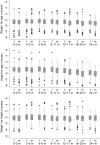Factors associated with increased risk of progression to respiratory syncytial virus-associated pneumonia in young Kenyan children
- PMID: 18482199
- PMCID: PMC2635480
- DOI: 10.1111/j.1365-3156.2008.02092.x
Factors associated with increased risk of progression to respiratory syncytial virus-associated pneumonia in young Kenyan children
Abstract
Objectives: To identify factors associated with developing severe respiratory syncytial virus (RSV) pneumonia and their commonality with all-cause lower respiratory tract infection (LRTI), in order to isolate those risk factors specifically associated with RSV-LRTI and identify targets for control.
Methods: A birth cohort of rural Kenyan children was intensively monitored for acute respiratory infection (ARI) over three RSV epidemics. RSV was diagnosed by immunofluorescence of nasal washings collected at each ARI episode. Cox regression was used to determine the relative risk of disease for a range of co-factors.
Results: A total of 469 children provided 937 years of follow-up, and experienced 857 all-cause LRTI, 362 RSV-ARI and 92 RSV-LRTI episodes. Factors associated with RSV-LRTI, but not RSV-ARI, were severe stunting (z-score < or =-2, RR 1.7 95%CI 1.1-2.8), crowding (increased number of children, RR 2.6, 1.0-6.5) and number of siblings under 6 years (RR 2.0, 1.2-3.4). Moderate and severe stunting (z-score < or =-1), crowding and a sibling aged over 5 years sleeping in the same room as the index child were associated with increased risk of all-cause LRTI, whereas higher educational level of the primary caretaker was associated with protection.
Conclusion: We identify factors related to host nutritional status (stunting) and contact intensity (crowding, siblings) which are distinguishable in their association with RSV severe disease in infant and young child. These factors are broadly in common with those associated with all-cause LRTI. The results support targeted strategies for prevention.
Figures


Similar articles
-
Respiratory syncytial virus infection and disease in infants and young children observed from birth in Kilifi District, Kenya.Clin Infect Dis. 2008 Jan 1;46(1):50-7. doi: 10.1086/524019. Clin Infect Dis. 2008. PMID: 18171213 Free PMC article.
-
Respiratory syncytial virus epidemiology in a birth cohort from Kilifi district, Kenya: infection during the first year of life.J Infect Dis. 2004 Nov 15;190(10):1828-32. doi: 10.1086/425040. Epub 2004 Oct 8. J Infect Dis. 2004. PMID: 15499540
-
Incidence and Risk Factors for Respiratory Syncytial Virus and Human Metapneumovirus Infections among Children in the Remote Highlands of Peru.PLoS One. 2015 Jun 24;10(6):e0130233. doi: 10.1371/journal.pone.0130233. eCollection 2015. PLoS One. 2015. PMID: 26107630 Free PMC article.
-
New advances in RSV: Is prevention attainable?Pediatr Pulmonol. 2025 Mar;60 Suppl 1(Suppl 1):S120-S122. doi: 10.1002/ppul.27310. Epub 2024 Oct 28. Pediatr Pulmonol. 2025. PMID: 39466029 Free PMC article. Review.
-
Severe respiratory syncytial virus infection in children: burden, management, and emerging therapies.Lancet. 2024 Sep 21;404(10458):1143-1156. doi: 10.1016/S0140-6736(24)01716-1. Epub 2024 Sep 9. Lancet. 2024. PMID: 39265587 Review.
Cited by
-
Association of RSV-A ON1 genotype with Increased Pediatric Acute Lower Respiratory Tract Infection in Vietnam.Sci Rep. 2016 Jun 16;6:27856. doi: 10.1038/srep27856. Sci Rep. 2016. PMID: 27306333 Free PMC article. Clinical Trial.
-
Viral burden and diversity in acute respiratory tract infections in hospitalized children in wet and dry zones of Sri Lanka.PLoS One. 2021 Dec 17;16(12):e0259443. doi: 10.1371/journal.pone.0259443. eCollection 2021. PLoS One. 2021. PMID: 34919553 Free PMC article.
-
Burden of Respiratory Syncytial Virus Associated Severe Pneumonia in Hospitalized Children.Int J Pediatr. 2021 Jun 30;2021:8269400. doi: 10.1155/2021/8269400. eCollection 2021. Int J Pediatr. 2021. PMID: 34306103 Free PMC article.
-
Epidemiology and risk factors of respiratory syncytial virus associated acute respiratory tract infection in hospitalized children younger than 5 years from Sri Lanka.Front Microbiol. 2023 Jun 26;14:1173842. doi: 10.3389/fmicb.2023.1173842. eCollection 2023. Front Microbiol. 2023. PMID: 37434712 Free PMC article.
-
Assessment of the WHO Stunting Framework using Ethiopia as a case study.Matern Child Nutr. 2017 Apr;13(2):e12310. doi: 10.1111/mcn.12310. Epub 2016 Apr 29. Matern Child Nutr. 2017. PMID: 27126511 Free PMC article.
References
-
- Aaby P. Malnutrition and overcrowding/intensive exposure in severe measles infection: review of community studies. Reviews of Infectious Diseases. 1988;10:478–491. - PubMed
-
- Aaby P, Coovadia H. Severe measles: a reappraisal of the role of nutrition, overcrowding and virus dose. Medical Hypotheses. 1985;18:93–112. - PubMed
-
- Aaby P, Bukh J, Lisse IM, Smits AJ. Measles mortality, state of nutrition, and family structure: a community study from Guinea-Bissau. Journal of Infectious Diseases. 1983;147:693–701. - PubMed
-
- Aaby P, Bukh J, Lisse IM, Smits AJ. Overcrowding and intensive exposure as determinants of measles mortality. American Journal of Epidemiology. 1984;120:49–63. - PubMed
-
- Adegbola RA, Falade AA, Sam BE, et al. The etiology of pneumonia in malnourished and well-nourished Gambian children. The Pediatric Infectious Disease Journal. 1994;13:975–982. - PubMed
Publication types
MeSH terms
Grants and funding
LinkOut - more resources
Full Text Sources
Medical

